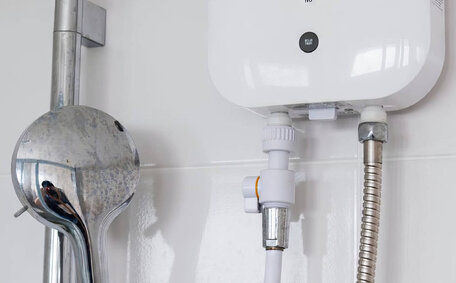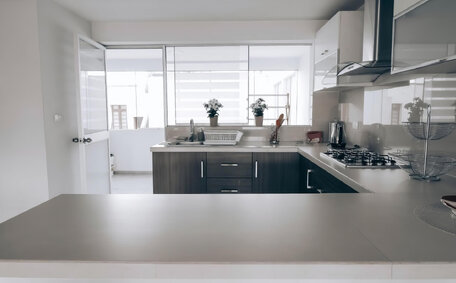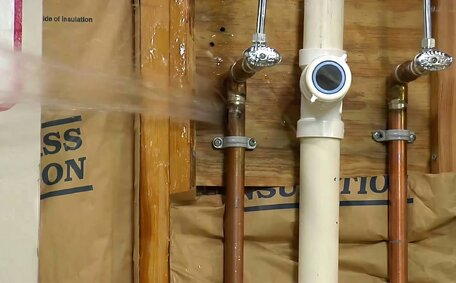Introduction to Installing a Gas Cooktop
Installing a new kitchen gas range can enhance your cooking experience and provide greater flexibility. However, proper installation is critical for safe and effective operation. At Bexley Plumbing, we have comprehensive knowledge in installing gas cooktops in accordance with Australian standards and safety guidelines.
Several key steps are necessary when setting up a new gas cooktop.
Our approach involves evaluating gas and electrical connections, selecting the appropriate design and dimensions, ensuring ventilation and clearance, preparing countertop cut-outs, connecting the cooktop with gas fittings, testing for leaks, and confirming the unit’s operation.
Following best practices for gas cooktop installation assures peace of mind with the assurance of correct execution for optimal performance and safety. As a Sydney-based plumbing business specialising in gas systems, Bexley Plumbing has the expertise to expertly install your new cooktop to the highest standards.
In the following sections we’ll guide you through the complete installation process of gas cooktops so you understand what’s involved at each stage.
Adhering to the required procedures will ensure reliable stove function for years. If at any point you need assistance, don’t hesitate to email or call our friendly team.
Assessing Space and Installation Requirements
It is important to rigorously assess the intended space before setting up your new gas cooktop, ensuring a proper fit and adherence to safety requirements. Evaluate the width, depth, and cutout dimensions of the chosen cooktop, ensuring it fits your base cabinets perfectly.
Examine the existing gas line capacity and the provision of a dedicated electrical circuit. When you’re changing levels to incorporate modern design into your kitchen specifications, this guarantees your new cooktop will settle in impeccably.
Ensure there is enough space on all sides, understanding that clearances differ by model but typically average 200mm, especially to comply with mandatory safety distances. Ensure these guidelines are followed.
Conducting this upfront planning confirms your cooktop can be installed safely andfunction optimallywithin the intended kitchen layout. Our experts are available to help with space assessments as required. Ensuring compatibility with the dimensions of your old gas cooktop is essential before starting the physical installation.
Gas and Electrical Setup
When installing a new gas cooktop, the gas line and gas fitting connections must be properly prepared. Check that your current gas line, compared with the old one, has sufficient capacity and pressure to power the cooktop, measuring this in Megajoules. It’s vital to ensure new gas lines meet the demand if the cooktop rating exceeds current capacity.
A licensed gas fitter must conduct all work on gas lines, in compliance with Australian Gas Installation Standards, including the assurance of adequate ventilation. A dedicated 230V powerpoint should be within 1.5 metres, whether installing an electric or gas cooktop.
Assess whether an isolation valve needs installing. Remember, all electrical work must be carried out by a certified electrician.
Advancing gas lines or electrical connections can be intricate, yet when skilfully executed, it permits gas cooktops to operate securely and efficiently, even enhancing the value of a sold home. Bexley Plumbing employs fully qualified gas fitters to handle all your installation work, ensuring safe and compliant setups. If your home requires gas or electrical modifications for cooktop installation, we can provide compliant, tailored solutions.
Choosing the Right Cooktop Size
When selecting a new gas cooktop, it’s crucial to choose the appropriate size to fit existing countertop space or the cabinet you intend to install it in.
Please note, first measure your countertop to accurately gauge the width of the available area. Residential model gas cookers typically range from 76 to 91 centimetres wide.
The depth of the cooktop is also important for ensuring it fits flush within the countertop cutout and to accommodate gas connections underneath. Cooktop depths are typically around 53 centimetres, going up to 86 centimetres for larger industrial models. Take into account adjoining walls or corners that might restrict depth.
The cutout dimensions must align with your existing cooktop’s specifications.
Cutouts are generally 3 to 8 centimetres wider than the cooktop’s overall width and depth. Our experts can guide you in determining the right sizing when installing new gas cooktops. Selecting a suitably sized gas cooktop ensures a seamless fit within your countertop.
Planning Clearances Around the Cooktop
Properly planning clearances around your new gas cooktop is crucial for safety. Australian Standard AS/NZS 5601.1 stipulates minimum clearance requirements from combustible surfaces above and beside where your cooktop going to prevent potential fire risks.
It’s vital to correctly space range hoods, installing them at least 650mm above the cooktop’s front edge, wok burner included. Adjacent combustible side walls require 200mm clearance from the nearest burner. Cabinetry and other flammable materials cannot be situated in zones where you take cooktop measurements.
If the stated clearances cannot be met due to space constraints, a section of non-combustible material can be used to provide protection. However, we recommend consulting Bexley Plumbing if your installation situation makes achieving the proper clearances difficult.
When planning, precisely measure spaces and compare them to the cooktop’s clearance specifications in the manual. Modifying cabinetry size or layout early on is easier than after the cooktop is in place. Our team is ready to offer guidance to ensure the installation meets your home’s clearance requirements.
Considering clearances early in your gas cooktop installation project ensures your new appliance performs safely for years to come, while avoiding hazards to you or your home.
Preparing the Countertop
Appropriately readying the countertop is paramount before enlistment of fully licensed experts to connect gas appliances, such as your new stove. Carefully measure and mark out the dimensions of the cut out area as specified in the appliance manual, allowing a gap of 1-3 inches around the cooktop edges.
Use a jigsaw and apply pipe sealant, following the cut lines accurately to create the countertop cutout opening. The opening should allow the cooktop to fit seamlessly within the countertop space.
For DIY-friendly countertops made from solid surfacing like granite, stainless steel, or tile, found at home centers, sealing the extremities around the cutout is essential to guard against moisture impairment over the duration.
Apply adhesive tape or a caulking compound along the perimeter. Let it fully cure before setting the cooktop in place. Consult our experts if altering the countertop is beyond your DIY capabilities.
With the countertop prepped and the cutout ready, you can safely proceed with positioning the cooktop according to the installation guide. The unit should fit snugly into the opening without gaps. Get in touch if you need assistance preparing your countertop during this important stage.
Installing the Cooktop
With adequate planning and preparation, you’re ready to start installing gas cooktops. The gas stove fitting process mandates hiring professional expertise to avert potential gas leaks or fire hazards stemming from improper setup.
Begin by turning off the gas cock to shut down the gas supply and disconnect any existing cooktop by removing gas fittings and plumbing connections near the power point. Ensure you use yellow Teflon tape to seal open ends near the gas line shutoff valve.
Carefully lower the new cooktop into the countertop cutout, applying pipejoint compound to the fittings, and replace your old model. Secure it in place temporarily with brackets on the underside or by placing weighted objects on top.
Connect the black gas pipe to the cooktop as per the appliance manual, ensuring a solid pipe joint with regulated fittings and sealant tape on all threads. Perform a thorough leak check by brushing on leak detector solution. Tighten any problem fittings and retest until no leaks are present.
Secure the cooktop to the countertop using mounting brackets or screws, whilst being careful not to pinch gas lines. Reconnect electrical power if required by your model. During the cooktop burner installation, confirm the igniters, burners and controls are all functioning properly.
By diligently adhering to the manufacturer’s instructions, you can ensure a secure and safe setup for your gas stove. Don’t hesitate to contact our Bexley Plumbing experts for support in correctly installing your new cooktop.
Connecting the Gas Supply
Connecting your new gas cooktop to establish a secure gas connection is a crucial stage that should only be performed by a licenced professional. Improper connection can also lead to dangerous gas leaks.
Start by turning off the gas cock and verify the gas shutoff is fully engaged. Make sure to disconnect and safely cap any old gas lines carrying natural gas leading to your oven or the previous cooktop if still present. Always use teflon tape on the open ends to temporarily seal them.
The gas connector kit supplied with your pristine cooktop encases the requisite end fitting and flexible gas pipe to establish a link with your gas supply. Attach the end connector fitting to the cooktop’s gas port on the gas pipe, tightening it securely. Then connect the pipe fittings leading back your home’s main gas supply valve.
After making all connections, turn on the gas and meticulously check for leaks by applying a leak detector solution to each joint and fitting. Ensure no bubbles emerge, then wipe the connections clean. Tighten any areas where leaks are detected and retest.
Once leak testing is complete with zero leaks found, reconfirm burner ignition and operation. Your newly installed gas cooktop can now be safely used for cooking. As always, contact Bexley Plumbing if you require professional assistance connecting gas appliances.
Testing for Gas Leaks
After installing and connecting the gas supply to your new cooktop, testing for potential gas leaks is an essential safety step. Using a specialised leak detection solution, thoroughly check ALL gas fittings, joints, connections and the cooktop itself for bubbles, which indicate escaping connector gas.
Apply the solution using a brush or spray bottle, and monitor closely for any bubbles, indicating a tight seal, for at least 30 seconds. Tighten any leaky fittings with an adjustable wrench and retest until no more leaks occur. Wipe connections clean when finished.
If a gas leak persists after multiple attempts at tightening, or bubbles immediately form indicating a severe leak, turn off the gas supply valve IMMEDIATELY. Evacuate the area and call our professionals or your gas utility company to make an emergency repair.
Even small unresolved gas leaks pose major risks, emphasising the importance of installing new appliances with meticulous care. Never operate a newly installed gas appliance until all connections have undergone leak checks by a licenced technician. Safety must come first with gas systems, so call the experts if you have any concerns.
Troubleshooting Common Issues
After installing your new gas cooktop, you may encounter some initial teething problems. Here are some troubleshooting tips for common gas stove issues:
Burners Not Lighting
If some or all burners on your gas stove fail to ignite, first confirm the gas supply valve is fully open.
Try relighting, allowing time for air to clear and up gas flow properly. Should issues continue, call your local gas service expert to verify that burner caps and bases are properly aligned. Gently clean the igniter with steel wool to remove residue buildup preventing sparking, a task sometimes best left to your gas company’s technician.
Weak Flame Strength
A weak cooktop flame often indicates low gas pressure, which may necessitate a technician’s visit. Check supply lines for blockages preventing sufficient gas volume. Try a different burner to isolate issues.
If flames remain small, contact your local gas utility company or plumber to inspect supply lines and regulator.
Gas Odour
Should you ever notice a gas odour from your new cooktop or within your surroundings, it’s time to act immediately by turning off the gas supply and evacuating the premises.
Do not operate appliances or lights. Call emergency services and do not re-enter until given the all clear. Get your gas system inspected for leaks.
While most issues after installing gas ranges stem from minor fixable problems, gas systems are not to be handled casually. Our fully licensed technicians can safely troubleshoot and repair your new gas stove.
If you have concerns about your appliance operation or experience persistent issues, contact the professionals at Bexley Plumbing on 1300 349 338 for prompt assistance.






